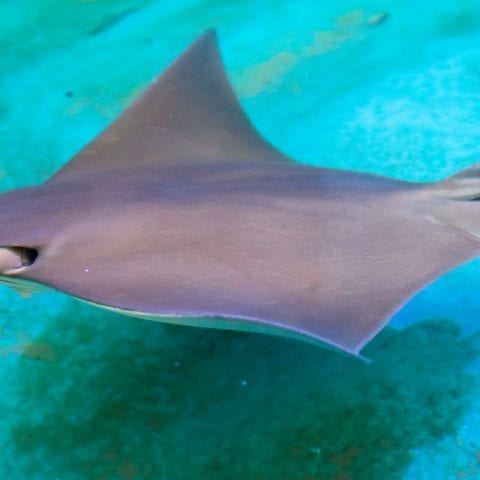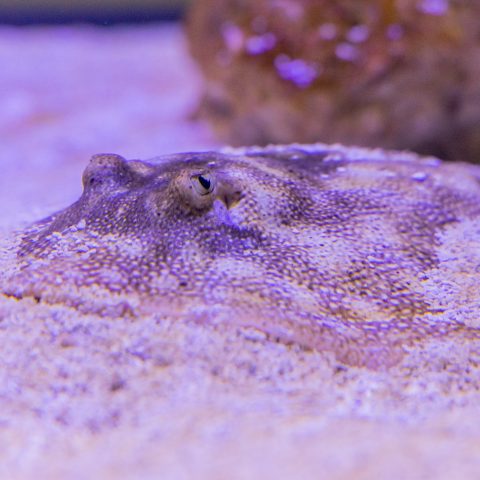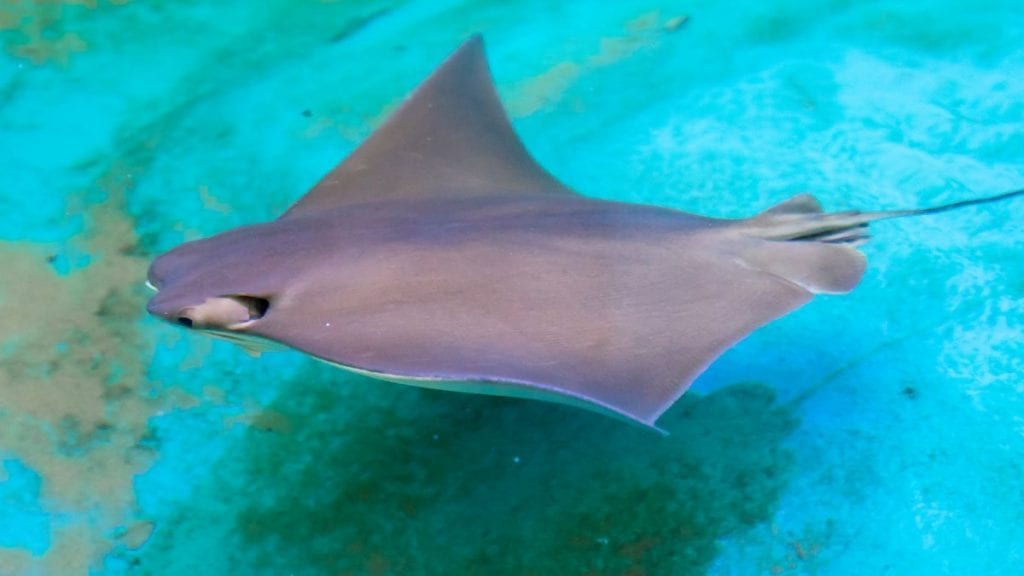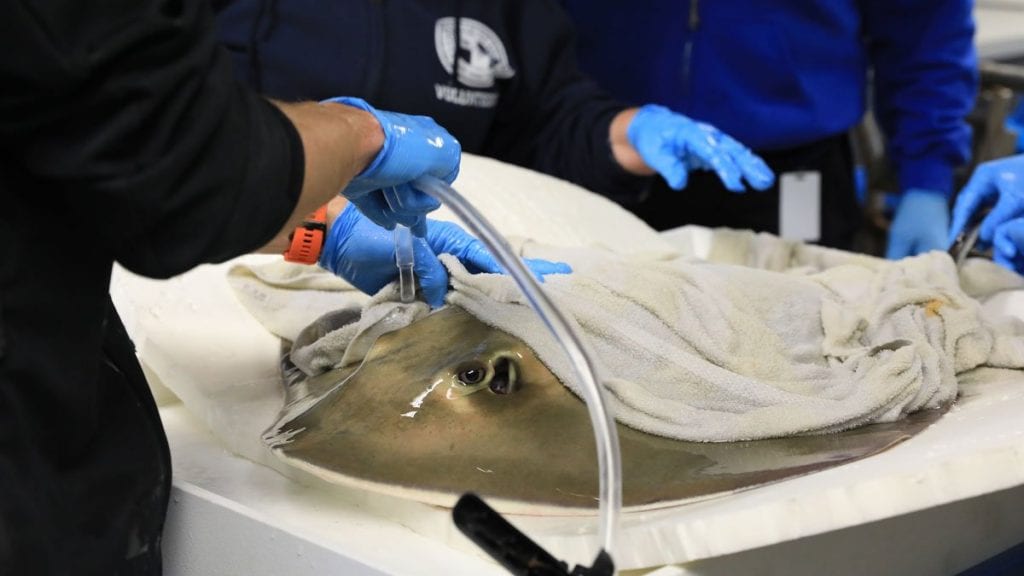Stingrays come in all shapes and sizes. Some can even create enough electric charges to stun a human! Rest assured, you can safely touch or even feed our cownose stingrays at Stingray Beach, or see them swim gracefully underwater at Mavis’s Rescue Hideaway. Learn more about stingray species below.
Where to See
Stingray Species
Cownose Ray

- Status
- Not Threatened
- Average Size
- 11-18 in
- Location
- Atlantic Ocean
- Threats
- Commercial fishing
- Defining Characteristic
- Head extends beyond disk
This stingray has a very broad disk and pointed wings. Its snout is indented in the middle to form two lobes, hence the name ”cownose”. Superficially, it resembles the eagle ray. The eyes are located in front, or anterior to, the beginning of the pectoral fins. It can grow to be seven feet wide and about 100 pounds. It may be seen in large schools in sand flats and mudflats stirring up food on the bottom with its wings, or pectoral fins.
Yellow Ray

- STATUS
- Least Concern
- AVERAGE SIZE
- 26 In
- LOCATION
- Atlantic Ocean, North Carolina Florida, Gulf of Mexico, Bahamas, and Caribbean
- DEFINING CHARACTERISTICS
- They inhabit clear marine environments and benefit from having the ability to rapidly change their color to camouflage and conceal themselves.
- HABITAT
- Shallow water in sandy for muddy habitats, often buried in the sand.
- DIET
- Marine worms, crabs, shrimp, lobsters, mollusks and bony fish Yellow stingrays arch their flat bodies off the bottom of the ocean, which make a space between the ray and the ocean floor and looks like a small cave. Small fish take shelter and are eaten by the ray.
Southern Stingray
- Status
- Data Deficient
- Average Size
- 160 lbs
- Location
- Atlantic Ocean
- Threats
- Commercial fishing
- Defining Characteristic
- Gray to dark brown coloring
This inshore species spends much of its time in shallow areas of sand or mud in search of food. The Southern Stingray’s diet consists of clams, crabs, shrimps, worms and small fish. Its disk is rhomboid in shape like the Atlantic’s disk, but is distinguishable by its blunt or rounded snout. The tail is rather long and whip-like with a barbed spine near the base.
Atlantic Stingray
- Status
- Least Concern
- Average Size
- 11 lb
- Location
- Atlantic Ocean
- Threats
- Commercial fishing
- Defining Characteristic
- Long snout
This has a prominently pointed snout, which distinguishes it from many of its relatives. Its dorsal surface is brown to yellowish-brown and its ventral side is whitish. It is a small species, growing to approximately two feet or 15 lbs.
Smooth Butterfly Ray
- Status
- Data Deficient
- Average Size
- 3-4 ft
- Location
- Eastern Atlantic Ocean
- Threats
- Commercial Fishing
- Defining Characteristic
- No Spine
This has a very broad disk, much wider than it is long. The tail is very short, with a keel on top and no tail spine. This species is unique among stingrays in that it can vary its color to better blend in with the sandy bottom of the sea. The butterfly ray can grow to be about four feet in width. It can be found in waters that are a few feet deep to about 150 feet deep. It is most often seen in late spring and summer in shallow, warm waters.
Lesser Electric Ray
- Status
- Least Concern
- Average Size
- 22-33 in
- Location
- Western Atlantic Ocean, Gulf of Mexico
- Threats
- Fishing, habitat loss
- Defining Characteristic
- Ability to create an electric shock
This stingray is much smaller than the Atlantic torpedo growing to about 15 inches. It lacks a stinging barb, but possesses two electric organs between its head and pectoral fins for self-defense and to stun its prey. Its much larger cousin, the Atlantic Torpedo (Torpedo nobiliana) can achieve a weight of more than 100 pounds. To stun its prey, the torpedo can administer a considerable electric shock. Voltages of 170 to 220 have been recorded. The electric ray and the electric eel are the only two species that can create enough charge to injure a human.
Spotted Eagle Ray
- Status
- Near Threatened
- Average Size
- 16 ft
- Location
- Oceans across the globe
- Threats
- Overfishing, pollution, population fragmentation
- Defining Characteristic
- Spotted Pattern
This has a wide, diamond shaped disk with whitish, yellow, or green spots on the dorsal side. The ventral side is relatively light in color. One or more sharp barbs are present at the base of a very long, black, whip-like tail. It has been known to grow to a width of 7.5 feet and a weight of 500 pounds. Eagle rays, as well as many other large rays may be seen swimming alone, in pairs, or in schools. They have shovel-shaped mouths with a wide, single row of teeth that allow them to dig up clams, oysters, and other organisms. Like some other large rays, they have been seen leaping clear out of the water and making loud, croaking sounds.
Atlantic Manta
- Status
- Vulnurable
- Average Size
- 3600 lbs
- Location
- Tropical, subtropical, temperate waters
- Threats
- Pollution, entanglement, harvesting
- Defining Characteristic
- Large, forward-facing mouth
This is the largest ray. It can reach a width of 22 feet, a length of 17 feet, and a weight of around two tons. It has two hornlike projections at the front of the head, which can help push food towards the mouth. These large creatures can oftentimes be seen basking near the surface of the water. Mantas are known to eat shrimp, mullet, and plankton. Juveniles eat anchovies, shrimp and copepods.
Devil Ray
- Status
- Endangered
- Average Size
- 4 ft
- Location
- Tropical, subtropical, temperate waters
- Threats
- Pollution, entanglement, harvesting
- Defining Characteristic
- Large, forward-facing mouth
The Devil Ray resembles the manta ray, but it is considerably smaller, reaching about four feet in width.




